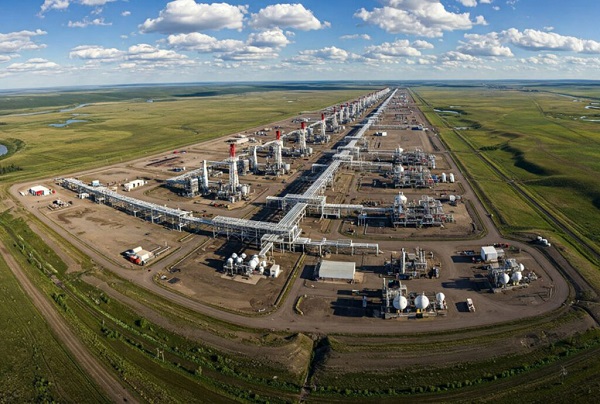Energy
The sudden, newfound support for LNG projects in Canada is truly remarkable.

From Resource Works
The sudden, newfound support for LNG projects in Canada is truly remarkable.
What’s all this? Green-leaning governments, federal and provincial, suddenly speaking in favour of liquefied natural gas (LNG) and other resource development?
It began with British Columbia Premier David Eby telling Bloomberg News that he’s optimistic that LNG Canada’s LNG-for-export plant at Kitimat, BC can be expanded in a way that satisfies its investors but without supercharging the province’s emissions.
This came as LNG Canada was reported continuing to look into possible Phase Two expansion. Such expansion would double the plant’s output of LNG to 14 million tonnes a year.
Industry reports say LNG Canada has been discussing with prime contractors their potential availability down the road. A key, though, is whether and how B.C. can provide enough electrical power.
The LNG Canada plant now is going through a pre-production testing program, and has finished welding on its first “train” (production line). LNG Canada is expected to go into full operation in mid-2025. And Malaysia’s Petronas (a 25% partner) has added three new LNG carriers to its fleet, to gear up for LNG Canada’s launch.
The Eby story noted that he has also thrown his support behind other projects — including hydrogen production and an electric-vehicle battery recycling plant — to create jobs and keep B.C.’s economy growing at a challenging time.
Then came Ottawa’s minister of innovation, science and industry, François-Philippe Champagne, who visited the Haisla Nation in B.C. to support its Cedar LNG project with partner Pembina Pipeline Corp.
Champagne declared: “This is the kind of project we want to see, where there are all the elements supporting attracting investments in British Columbia.”
His government news release said: “This project presents an exciting opportunity for Canada, as it is expected to commercialize one of the lowest-carbon-intensity liquified natural gas (LNG) facilities in the world and represents the largest Indigenous-majority-owned infrastructure project in Canada.”
Champagne went on to tell The Terrace Standard that “We are in active conversations with Pembina and Haisla First Nations. We are saying today that we will support the project, but discussions are still ongoing.’
There had already been reports that Export Development Canada is set to lend Cedar LNG $400-$500 million.
And then came federal minister Jonathan Wilkinson, announcing to the national Energy and Mines Ministers’ Conference in Calgary that Ottawa “will get clean growth projects built faster” by streamlining regulatory processes and moving to “make good approvals faster.”
Wilkinson has long talked, too, of streamlining and speeding up approval processes for resource projects in general, especially for mining for critical minerals. “(We’re) looking at how do we optimise the regulatory and permanent processes so you can take what is a 12- to 15-year process and bring it down to maybe five.”
The Canada Energy Regulator now is inviting input on its plans to improve the efficiency and predictability of project reviews.
All this as Deloitte Canada consultants reported that “the natural gas sector is poised for significant growth, driven by ongoing LNG projects and rising demand for gas-fired electricity generation in Canada.”
And energy giant BP said that under its two new energy ‘scenarios’, world demand for LNG in 2030 grows by 30-40% above 2022 levels, then increases by more than 25% over the subsequent 20 years.
Wilkinson earned pats on the back from some provincial ministers at the Calgary conference, but Alberta’s minister of energy and minerals, Brian Jean, aired concerns over how Ottawa’s new “greenwashing” law would impact the oil and gas sector.
Under it, companies (and individuals) must prove the truth of their public statements on climate benefits of their products or programs, or face potential millions in fines. But the ground rules for this legislation have not yet been announced.
(Jean was not alone. Other critics included CEO Karen Ogen of the First Nations LNG Alliance, who said the new law “could be used as one more tool to discourage resource companies that might seek Indigenous partnerships, and to obstruct Indigenous investment in energy projects, and frustrate Indigenous benefits from resource projects.”)
Wilkinson replied that the Competition Bureau needs to provide information so people understand how the rules apply and what is actionable.
“I think once that is done, this will be, perhaps, a bit of a different conversation. I would expect that the guidance will be something like folks simply have to have a good faith basis to believe what they’re saying. And assuming that is true, I think the sector probably will calm down.”
No pats on the back for Ottawa, though, from the mining industry or the oil-and-gas sector.
Aiming to combat China’s efforts to corner the market in critical minerals, Canada is making it harder for foreign firms to take over big Canadian mining companies. Major mining shares quickly dropped in value.
And Heather Exner-Pirot of the Macdonald-Laurier Institute and special advisor to the Business Council of Canada, says: “We produced less critical minerals last year than we did in 2019. We’re producing less copper, less nickel, less platinum, less cobalt, all these things. And the investment has not picked up; in real dollars it’s almost half of what it was in 2013 . . . and the regulatory system is still a huge barrier to that development.”
On top of that, the petroleum sector has long protested that federal moves to limit oil and gas emissions will, in practice, limit production.
While governments signalled support for LNG, supporters of natural-resource development quickly sent clear messages to governments of all levels.
Calgary-based Canada Action, for one, reminded governments that the oil and gas sector is projected to generate more than in $1.1 trillion in revenue to governments from 2000 through 2032. And that the oil and gas sector supports nearly 500,000 direct and indirect jobs across the country.
Then the industry-supporting Fraser Institute pointed out that business investment in Canada’s extractive sector (mining, quarrying, and oil and gas) has declined substantially since 2014.
“In fact, adjusted for inflation, business investment in the oil and gas sector has declined 52.1 per cent since 2014, falling from $46.6 billion in 2014 to $22.3 billion in 2022. In percentage terms the decline in non-conventional oil extraction was even larger at 71.2 percent, falling from $37.3 billion in 2014 to $10.7 billion in 2022. . . .
“One of the major challenges facing Canadian prosperity are regulatory barriers, particularly in the oil and gas sector.”
Over to government, then, to reduce those barriers.
Following the recent positive moves listed above from two levels of government, there’s an obvious question: Would there happen to be federal and provincial elections in the offing?
Yes: B.C. will hold its next general election on or before October 19. And the feds go to the polls for an election on or before October 20.
Stand by for more promises.
2025 Federal Election
Poilievre To Create ‘Canada First’ National Energy Corridor

From Conservative Party Communications
Poilievre will create the ‘Canada First’ National Energy Corridor to rapidly approve & build the infrastructure we need to end our energy dependence on America so we can stand up to Trump from a position of strength.
Conservative Leader Pierre Poilievre announced today he will create a ‘Canada First’ National Energy Corridor to fast-track approvals for transmission lines, railways, pipelines, and other critical infrastructure across Canada in a pre-approved transport corridor entirely within Canada, transporting our resources within Canada and to the world while bypassing the United States. It will bring billions of dollars of new investment into Canada’s economy, create powerful paycheques for Canadian workers, and restore our economic independence.
“After the Lost Liberal decade, Canada is poorer, weaker, and more dependent on the United States than ever before,” said Poilievre. “My ‘Canada First National Energy Corridor’ will enable us to quickly build the infrastructure we need to strengthen our country so we can stand on our own two feet and stand up to the Americans.”
In the corridor, all levels of government will provide legally binding commitments to approve projects. This means investors will no longer face the endless regulatory limbo that has made Canadians poorer. First Nations will be involved from the outset, ensuring that economic benefits flow directly to them and that their approval is secured before any money is spent.
Between 2015 and 2020, Canada cancelled 16 major energy projects, resulting in a $176 billion hit to our economy. The Liberals killed the Energy East pipeline and passed Bill C-69, the “No-New-Pipelines” law, which makes it all but impossible to build the pipelines and energy infrastructure we need to strengthen the Canadian economy. And now, the PBO projects that the ‘Carney cap’ on Canadian energy will reduce oil and gas production by nearly 5%, slash GDP by $20.5 billion annually, and eliminate 54,400 full-time jobs by 2032. An average mine opening lead time is now nearly 18 years—23% longer than Australia and 38% longer than the US. As a result of the Lost Liberal Decade, Canada now ranks 23rd in the World Bank’s Ease of Doing Business Index for 2024, a seven-place drop since 2015.
“In 2024, Canada exported 98% of its crude oil to the United States. This leaves us too dependent on the Americans,” said Poilievre. “Our Canada First National Energy Corridor will get us out from under America’s thumb and enable us to build the infrastructure we need to sell our natural resources to new markets, bring home jobs and dollars, and make us sovereign and self-reliant to stand up to Trump from a position of strength.”
Mark Carney’s economic advice to Justin Trudeau made Canada weaker while he and his rich friends made out like bandits. While he advised Trudeau to cancel Canadian energy projects, his own company spent billions on pipelines in South America and the Middle East. And unlike our competitors Australia and America, which work with builders to get projects approved, Mark Carney and Steven Guilbeault’s radical “keep-it-in-the-ground” ideology has blocked development, killed jobs, and left Canada dependent on foreign imports.
“The choice is clear: a fourth Liberal term that will keep our resources in the ground and keep us weak and vulnerable to Trump’s threats, or a strong new Conservative government that will approve projects, build an economic fortress, bring jobs and dollars home, and put Canada First—For a Change.”
Daily Caller
Cover up of a Department of Energy Study Might Be The Biggest Stain On Biden Admin’s Legacy


From the Daily Caller News Foundation
By David Blackmon
News broke last week that the Biden Department of Energy (DOE), led by former Secretary Jennifer Granholm, was so dedicated to the Biden White House’s efforts to damage the dynamic U.S. LNG export industry that it resorted to covering up a 2023 DOE study which found that growth in exports provide net benefits to the environment and economy.
“The Energy Department has learned that former Secretary Granholm and the Biden White House intentionally buried a lot of data and released a skewed study to discredit the benefits of American LNG,” one DOE source told Nick Pope of the Daily Caller News Foundation.. “[T]he administration intentionally deceived the American public to advance an agenda that harmed American energy security, the environment and American lives.”
And “deceived” is the best word to describe what happened here. When the White House issued an order signed by the administration’s very busy autopen to invoke what was supposed to be a temporary “pause” in permitting of LNG infrastructure, it was done at the behest of far-left climate czar John Podesta, with Granholm’s full buy-in. As I’ve cataloged here in past stories, this cynical “pause” was based on the flimsiest possible rationale, and the “science” supposedly underlying it was easily debunked and fell completely apart over time.
But the ploy moved ahead anyway, with Granholm and her DOE staff ordered to conduct their own study related to the advisability of allowing further growth of the domestic LNG industry. We know now that study already existed but hadn’t reached the hoped-for conclusions.
The two unfounded fears at hand were concerns that rising exports of U.S. LNG would a) cause domestic prices to rise for consumers, and b) would result in higher emissions than alternative energy sources. As the Wall Street Journal notes, a draft of that 2023 study “shows that increased U.S. LNG exports would have negligible effects on domestic prices while modestly reducing global greenhouse gas emissions. The latter is largely because U.S. LNG exports would displace coal in power production and gas exports from other countries such as Russia.”
An energy secretary and climate advisor interested in seeking truth based on science would have made that 2023 study public, and the “pause” would have been a short-lived, temporary thing. Instead, the Biden officials decided to try to bury this inconvenient truth, causing the “pause” to endure right through the final day of the Biden regime with a clear intention of turning it into permanent policy had Kamala Harris and her “summer of joy” campaign managed to prevail on Nov. 5.
Fortunately for the country, voters chose more wisely, and President Trump included ending this deceitful “pause” exercise as part of his Day One agenda. No autopen was involved.
So, the thing is resolved in favor of truth and common sense now, but it is important to understand exactly what was at stake here, exactly how important an industry these Biden officials were trying to freeze in place.
In an interview on Fox News Monday, current Energy Secretary Chris Wright did just that, pointing out that, fifteen years ago, America was “the largest importer of natural gas in the world. Today, we’re the largest exporter.”
He went onto add that, “the Biden administration put a pause on LNG exports 14 months ago, January of 2024, sending a message to the world that maybe the US isn’t going to continue to grow our exports. Think of the extra leverage that gives Russia, the extra fear that gives the Europeans or the Asians that are dying for more American energy.”
Then, Wright supplied the kicker: “They did this in spite of their own study that showed increasing LNG exports would reduce greenhouse gas emissions and have a negligible impact on price.” It was an effort, Wright concludes, to kill what he says is “America’s greatest energy advantage.”
This incident is a stain on the Biden administration and its senior leaders. The stain becomes more indelible when we remember that, when asked by Speaker Mike Johnson why he had signed that order, Joe Biden himself had no memory of doing so, telling Johnson, “I didn’t do that.”
Sadly, we know now there’s a good chance Mr. Biden was telling the speaker the truth. But someone did it, and it’s a travesty.
David Blackmon is an energy writer and consultant based in Texas. He spent 40 years in the oil and gas business, where he specialized in public policy and communications.
-

 Business1 day ago
Business1 day agoDOGE discovered $330M in Small Business loans awarded to children under 11
-

 2025 Federal Election1 day ago
2025 Federal Election1 day agoThe High Cost Of Continued Western Canadian Alienation
-

 COVID-191 day ago
COVID-191 day ago17-year-old died after taking COVID shot, but Ontario judge denies his family’s liability claim
-

 Economy2 days ago
Economy2 days agoSolar and Wind Power Are Expensive
-

 Business2 days ago
Business2 days agoWhy a domestic economy upgrade trumps diversification
-

 Daily Caller1 day ago
Daily Caller1 day agoCover up of a Department of Energy Study Might Be The Biggest Stain On Biden Admin’s Legacy
-

 Economy2 days ago
Economy2 days agoClearing the Path: Why Canada Needs Energy Corridors to Compete
-

 Business2 days ago
Business2 days agoTariff-driven increase of U.S. manufacturing investment would face dearth of workers





